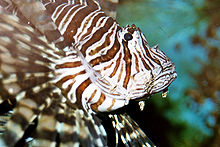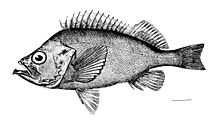Scorpaeniformes
| Scorpaeniformes | |
|---|---|

| |
| Scorpaenidae: Pterois antennata | |
| Scientific classification | |
| Kingdom: | Animalia |
| Phylum: | Chordata |
| Class: | Actinopterygii |
| Superorder: | Acanthopterygii |
| Order: | Scorpaeniformes Greenwood et al., 1966 |
| Type species | |
| Scorpaena porcus | |
| Suborders | |
|
see text | |
The Scorpaeniformes /skɔːrˈpiːnɪfɔːrmiːz/ are a diverse order of ray-finned fish, including the lionfishes and sculpins, but have also been called the Scleroparei. It is one of the five largest orders of bony fishes by number of species, with over 1,320.[1]
They are known as "mail-cheeked" fishes due to their distinguishing characteristic, the suborbital stay: a backwards extension of the third circumorbital bone (part of the lateral head/cheek skeleton, below the eye socket) across the cheek to the preoperculum, to which it is connected in most species.[2]
Scorpaeniform fishes are carnivorous, mostly feeding on crustaceans and on smaller fish. Most species live on the sea bottom in relatively shallow waters, although species are known from deep water, from the midwater, and even from fresh water. They typically have spiny heads, and rounded pectoral and caudal fins. Most species are less than 30 cm (12 in) in length, but the full size range of the order varies from the velvetfishes belonging to the family Aploactinidae, which can be just 2 cm (0.79 in) long as adults,[2] to the (Erilepis zonifer), which can reach 183 cm (6.00 ft) in total length.[3]
One of the suborders of the scorpaeniformes is the scorpaenoidei. This suborder of scorpaeniformes are usually found in the benthic zone, which is the lowest region of any water body such as oceans or lakes. There are two groups of the scorpaenoidei. The sea robins is the first, which are further classified into two families: the sea robins and the armored sea robins. One significant difference between the two families of sea robins is the presence of spine-bearing plate on the armored sea robins which is absent in the sea robins family.
The second group of the scorpaenoidei suborder is the scorpionfishes, which according to Minouri Ishida's work in 1994 and recent studies, have twelve families. The scorpionfishes are very dynamic in size with the smallest one having a range of 2–3 cm, while the largest have a length of approximately 100 cm.[4]
Classification[]
The division of Scorpaeniformes into families is not settled; accounts range from 26[5] to 35 families.[6][7] The 5th edition of Fishes of the World classifies the order as follows:[8][9]



Order Scorpaeniformes
- Suborder Scorpaenoidei
- Family Scorpaenidae Risso, 1827 (Scorpionfishes)
- Family Aploactinidae Jordan & Starks, 1904 (Velvetfishes)
- Family Eschmeyeridae Mandrytsa, 2001 (the cofish)
- Family Pataecidae Gill, 1872 (Australian prowlfishes)
- Family Gnathanacanthidae Gill, 1892 (Red velvetfish)
- Family Congiopodidae Gill, 1889 (Racehorses, pigfishes or horsefishes)
- Suborder Platycephaloidei
- Family Triglidae Rafinesque, 1815 (Searobins)
- Family Peristediidae Jordan & Gilbert, 1883 (Armored searobins)
- Family Bembridae Kaup, 1873 (Deepwater flatheads)
- Family Platycephalidae Swainson, 1839 (Flatheads)
- Family Hoplichthyidae Kaup, 1873 (Ghost flatheads)
- Suborder Normanichthyiodei
- Family Normanichthyidae , 1837 (the Barehead scorpionfish or mote sculpin)
- Suborder Zoarcoidei
- Family Bathymasteridae Jordan & Gilbert, 1883 (Ronquils)
- Family Smith, 1902 (Spinous eelpouts)
- Family Zoarcidae Swainson, 1839 (Eelpouts)
- Family Stichaeidae Gill, 1864 (Pricklebacks)
- Family Cryptacanthodidae Gill, 1861 (Wrymouths)
- Family Pholidae Gill, 1893 (Gunnels)
- Family Anarhichadidae Bonaparte, 1835 (Wolffishes)
- Family Ptilichthyidae Jordan & Gilbert, 1883 (Quillfish)
- Family Zaproridae Jordan, 1896 (Prowfishes)
- Family Scytalinidae Jordan & Starks, 1895 (Graveldivers)
- Suborder Gasterosteoidei
- Family Hypoptychidae Steindachner, 1880 (the Korean Sandlance)
- Family Aulorhynchidae Gill (1861) (Tubesnouts)
- Family Gasterosteidae Bonaparte, 1831 (Sticklebacks)
- Suborder Cottoidei
- Superfamily
- Family Anoplopomatidae Jordan & Gilbert, 1883 (Sablefishes)
- Superfamily
- Family Zaniolepididae Jordan & Gilbert, 1883 (Combfishes)
- Superfamily
- Family Hexagrammidae Jordan, 1888 (Greenlings)
- Superfamily H. Imamura, S. Shirai, M. Yabe, 2005
- Family Trichodontidae Bleeker, 1859 (Sandfishes)
- Superfamily Cottoidea
- Family Jordan & Evermann, 1898 (Longfin sculpins)
- Family Rhamphocottidae Jordan & Gilbert, 1883 (Grunt sculpins)
- Family Scorpaenichthyidae Jordan & Evermann, 1898
- Family Agonidae Swainson, 1839 (Poachers and searavens)
- Family Cottidae Bonaparte, 1831 (Sculpins)
- Family Psychrolutidae Günther, 1861 (Bighead sculpins)
- Family Bathylutichthyidae & , 1990 (Antarctic sculpins)
- Superfamily
- Family Cyclopteridae Bonaparte, 1831 (lumpfishes or lumpsuckers)
- Family Liparidae Gill, 1861 (Snailfishes)
- Superfamily
This classification is not settled, however, and some authorities classify these groupings largely within the Order Perciformes as the suborders Scorpaenoidei, Platycephaloidei, Triglioidei and Cottoidei, Cottodei including the infraorders Anoplopomatales, Zoarcales, Gasterosteales, Zaniolepidoales, Hexagrammales and Cottales. These infraorders largely correspond with the superfamilies in the Cottoidei set out in the 5th edition of Fishes of the World.[10]
Timeline of genera[]

See also[]
Notes[]
References[]
- ^ Umich.edu
- ^ a b Eschmeyer, William N. (1998). Paxton, J.R.; Eschmeyer, W.N. (eds.). Encyclopedia of Fishes. San Diego: Academic Press. p. 175. ISBN 0-12-547665-5.
- ^ Froese, Rainer and Pauly, Daniel, eds. (2021). "Erilepis zonifer" in FishBase. June 2021 version.
- ^ "Scorpaeniformes II (Scorpionfishes and Relatives) | Encyclopedia.com". www.encyclopedia.com. Retrieved 11 April 2020.
- ^ "Scorpaeniformes". Integrated Taxonomic Information System. Retrieved 31 March 2006.
- ^ William N. Eschmeyer; Carl J. Ferraris; Mysi D. Hoang; Douglas J. Long (1998). Catalog of Fishes. California Academy of Sciences. ISBN 0-940228-47-5.
- ^ Froese, Rainer, and Daniel Pauly, eds. (2006). "Scorpaeniformes" in FishBase. February 2006 version.
- ^ J. S. Nelson; T. C. Grande; M. V. H. Wilson (2016). Fishes of the World (5th ed.). Wiley. pp. 467–495. ISBN 978-1-118-34233-6.
- ^ Richard van der Laan; William N. Eschmeyer & Ronald Fricke (2014). "Family-group names of Recent fishes". Zootaxa. 3882 (2): 001–230. Archived from the original on 10 March 2021. Retrieved 21 February 2020.
- ^ Ricardo Betancur-R; Edward O. Wiley; Gloria Arratia; et al. (2017). "Phylogenetic classification of bony fishes". BMC Evolutionary Biology. 17 (162). doi:10.1186/s12862-017-0958-3.
- Sepkoski, Jack (2002). "A compendium of fossil marine animal genera". Bulletins of American Paleontology. 364: 560. Retrieved 17 May 2011.
- Scorpaeniformes
- Ray-finned fish orders